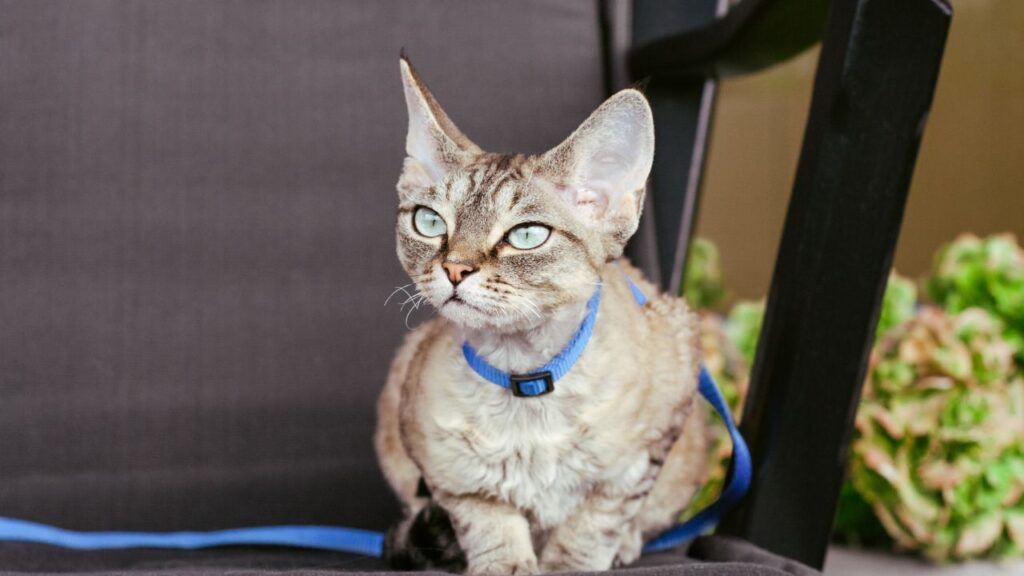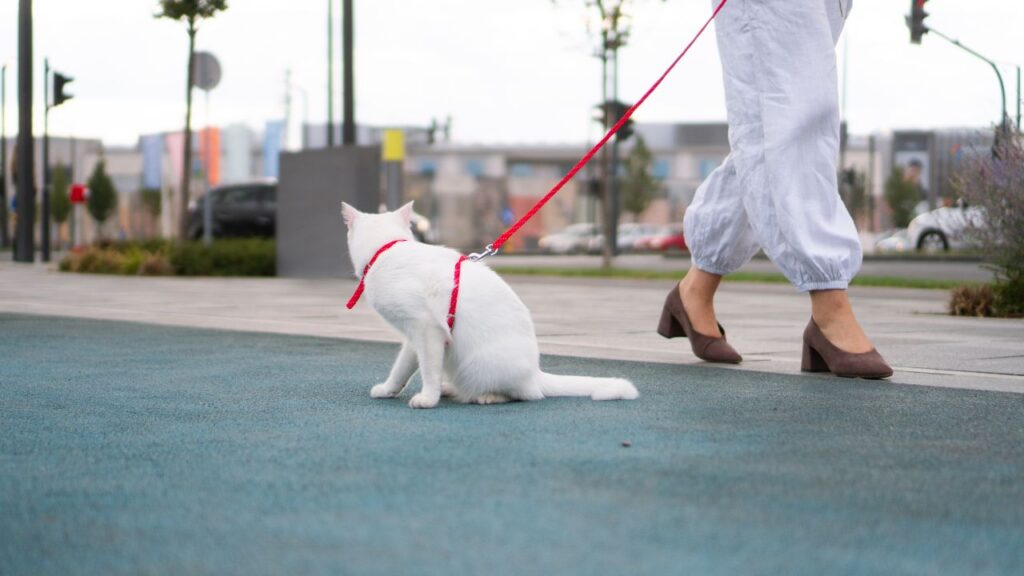If you’ve ever watched a dog prance around on a leash and thought, “Wouldn’t that be cute if my cat could do that too?”—you’re not alone. The idea of walking your cat indoors on a leash may sound a bit quirky at first, but it’s absolutely possible! Many cat owners are discovering the joy of leash training, not just for outdoor adventures, but also as a way to enrich their cats’ indoor lives.
How to train a cat to walk on a leash indoors may not be as hard as it seems—yes, cats are independent and don’t naturally take to walking on a leash like dogs, but with patience, the right equipment, and a solid approach, you can totally teach your feline friend this cool trick.
So, if you’ve ever wondered how to get your cat strolling around the house with you like your furry little walking buddy, you’re in the right place. Let’s dive into the world of leash training, and I’ll walk you through every step of the process!
Why Leash Train Your Cat Indoors?
Before we dive into the “how,” let’s take a moment to think about the why. Why should you bother training your cat to walk on a leash indoors? Well, here are a few benefits to consider:
- Mental and physical stimulation: Cats can get bored just like dogs, especially if they’re indoor-only. A walk around the house helps break up their routine, giving them a little mental workout and physical exercise.
- Bonding time: Leash training can strengthen the bond between you and your cat. It’s a fun way to spend quality time together, and it helps build trust.
- Safety and control: While it’s great to let your cat roam, there are places in your home (or outside) that might be off-limits. A leash gives you better control when needed, preventing your cat from darting into areas they shouldn’t.
- Entertainment for you: Admit it—watching your cat strut around on a leash is pretty adorable, and it’ll definitely get some “awws” from your friends and family.
Step-by-Step Guide: How to Train a Cat to Walk on a Leash Indoors
Now that you’re convinced, let’s jump into the process! Leash training a cat is a gradual process that requires patience and positive reinforcement. Here’s how to train a cat to walk on a leash indoors:

Step 1: Choose the Right Leash and Harness
Before you even start the training process, you need to make sure you have the right gear. Here’s what you should look for:
- Harness: Not all harnesses are created equal. Choose a well-fitted, adjustable harness designed for cats. These are usually soft, breathable, and easy to adjust. Avoid collar-based leashes, as they can be uncomfortable or even dangerous for cats.
- Leash: A lightweight, short leash (around 4-6 feet) is perfect for indoor training. You don’t want too much slack, as it will be harder to guide your cat.
Why does the right harness matter? Cats are more sensitive than dogs, and a bad harness can cause them stress or discomfort. So take your time to choose one that’s both comfortable and safe.
Step 2: Let Your Cat Get Used to the Harness
Cats can be a little wary of new things—especially something that’s going to be around their body. The first thing you need to do is get your cat comfortable with the harness. Here’s how:
- Introduce the harness slowly: Place it near your cat’s resting spot or food bowl so they can sniff and investigate it. Don’t force them to wear it right away—let them approach it on their own terms.
- Put the harness on for short periods: Once they’re used to the sight and smell, gently slip the harness on for a few minutes. You might need to distract your cat with a treat or their favorite toy to keep them calm.
- Gradually increase wear time: Over the next few days, start increasing the amount of time your cat wears the harness. Start with 5 minutes and gradually extend to 10 or 15 minutes. If they start to resist or seem uncomfortable, remove it and try again later.
Step 3: Attach the Leash and Let Them Explore
Once your cat is comfortable with the harness, it’s time to attach the leash and let them get used to the feel of it. At this point, your cat may still be a little confused about this new accessory, but don’t worry!
- Attach the leash: Clip the leash to the harness, but don’t pull on it just yet. Let your cat drag the leash around the house for a little while. This allows them to get used to the sensation of the leash moving along behind them.
- Let your cat explore: Give your cat plenty of space to explore with the leash attached. Allow them to move freely without interference. Keep an eye on them to make sure they’re not getting tangled or stressed.
Step 4: Lead Your Cat Around the House
Now the fun begins! Once your cat is comfortable wearing the harness and leash, you can start guiding them around the house. But remember, patience is key.
- Use treats and praise: Hold the leash gently and encourage your cat to walk with you by using treats and praise. Cats respond well to food rewards, so make sure to offer them whenever they make any progress.
- Start with small steps: At first, guide your cat a few feet in one direction, and then reward them when they follow you. Keep the sessions short—no more than 10 minutes at a time to avoid overwhelming your cat.
- Be patient: Some cats will start walking right away, while others may take a little longer to get the hang of it. Don’t rush the process; let your cat go at their own pace.
Pro tip: Use a toy to encourage movement. If your cat is hesitant to walk, dangle a favorite toy just in front of them to lure them forward. This will make the experience more enjoyable and engaging.
Step 5: Gradually Increase Distance and Complexity
As your cat starts to get the hang of walking on the leash indoors, you can gradually increase the complexity of your training. Here’s how:
- Increase the distance: Once your cat is walking a few feet at a time, try to increase the length of the walks. Guide them around the room or through different areas of your home.
- Use obstacles: As your cat gets more comfortable, you can start using obstacles like furniture or cat trees to create a little course. Encourage your cat to navigate around these obstacles using the leash.
- Practice in different areas: Try practicing in different rooms or even outside, but be mindful that outdoor distractions can make things harder for your cat.

Common Mistakes to Avoid When Leash Training Your Cat
Like any training process, there are common pitfalls that cat owners should watch out for. Here are a few things to keep in mind:
1. Rushing the Process
Cats are not dogs—they need time to adjust. Don’t rush your cat into walking on the leash too quickly. Gradual steps are the key to success.
2. Using the Wrong Type of Harness
A harness that doesn’t fit properly or isn’t designed for cats can lead to discomfort or even injury. Take the time to find the right harness before starting the training.
3. Too Much Frustration
If your cat is getting frustrated or stressed, it’s important to take a break. Training sessions should be fun and low-pressure.
Frequently Asked Questions (FAQs)
Q: Can I train an adult cat to walk on a leash indoors?
A: Yes! Adult cats can definitely be trained to walk on a leash indoors. It may take a little longer, but with patience and persistence, it’s absolutely possible.
Q: How do I know if my cat is ready to walk on a leash outdoors?
A: Once your cat is confidently walking on the leash indoors, you can consider taking them outside. Start with a quiet, enclosed area like your backyard or a balcony.
Q: How often should I train my cat to walk on a leash?
A: Keep training sessions short (around 10 minutes), and practice 2-3 times per week. Consistency is key to success!
Conclusion: Enjoy the Journey!
Training your cat to walk on a leash indoors is a rewarding experience that strengthens your bond with your feline friend. While it takes time and patience, the results are well worth it! Remember to keep the process fun, stay positive, and reward your cat for their progress. Soon enough, your cat will be confidently walking around your home—whether it’s for exercise, exploration, or just to show off to your guests.

